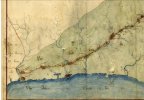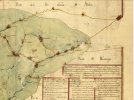caminka
Veteran Member
- Time of past OR future Camino
- see signature
during my research about via bayona I came upon this thesis - I'm not sure what the actual title is, actually -, but on pages 32 and 33 is a beautiful map drawn in 1765 which shows the entire Camino Real de Coches in gipuzkoa. it shows both the old route via tunél de san adrián and the new route via mondragón and another pass more to the west. almost every town is drawn individually! 
and it also cleared my answers about where did pilgrims cross river bidasoa from france to spain (in a barge or later via a bridge). the crossing is upstream from irun on the spot where the river exits the mountains and before it widens towards the sea. there are two villages named behobie on either side of it, béhobie on the french side and behobia on the spanish side.
plus, it confirms the different course of this postal route in álava, the route that guillaume manier in 1726 and arnold von harff in 1498-99 have taken, via galarreta and audikana.


and it also cleared my answers about where did pilgrims cross river bidasoa from france to spain (in a barge or later via a bridge). the crossing is upstream from irun on the spot where the river exits the mountains and before it widens towards the sea. there are two villages named behobie on either side of it, béhobie on the french side and behobia on the spanish side.
plus, it confirms the different course of this postal route in álava, the route that guillaume manier in 1726 and arnold von harff in 1498-99 have taken, via galarreta and audikana.


Last edited:
















